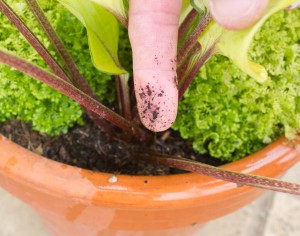Watering becomes increasingly important during drought, which often occurs at this time of year, so here are a few tips, so your plants flourish.

Check hanging baskets and containers three times a day, if possible; push your fingers into the compost, if is moist, compost crumbs stick to your fingers; if they are clean, give the compost a thorough soaking. Don’t bother watering lawns, they are surprisingly resilient and soon become green once the rain returns. Water borders and vegetable plots in the evening, the water then soaks into the soil, rather than evaporating in the sunshine. Water thoroughly – ‘a little and often’ only encourages roots to the surface where they are more vulnerable to drought and water the soil, not the plants! ‘Grey water’ recycled from baths and washbasins can be used if you only add a small amount of detergent and not on edible crops.
Rhododendrons and camellias form next year’s flower buds from mid – summer until September. During this time the compost or soil around them should never dry out. If it does, buds will not be formed or they will shed those that have already appeared. Check your plants daily and water before the onset of dry weather, using stored rain water, or ‘soft water’ to keep the soil moist. Mulching with well rotted organic matter helps to retain moisture; do this when the soil is moist, in spring – put this in your gardening diary, so you remember next year! Plants growing in pots are particularly vulnerable and may need watering twice a day. Save rainwater for plants which like growing in acidic conditions.
Overwintering Japanese onions which provide an early crop next year, should be sown from mid to late August, depending on whether you are in the north or south of the country. Timing is critical. Sow too early and they ‘run to seed’, too late and they won’t survive the winter. Rake high nitrogen fertiliser into the seedbed before sowing then sow the seeds 2.5cm apart on rows 30cm apart. Feed them with nitrogen again in spring, for the highest yields. ‘Express Yellow OX’ and ‘Buffalo’ are excellent varieties. There is still time to sow perennial spinach and fast growing ‘early’ vegetables that would normally be sown in spring, for crops that mature before autumn and look out for especially prepared potatoes, which can be planted now so you have ‘new’ potatoes for Christmas dinner.
Late summer is the time to collect seed hardy and half-hardy annuals. F1 hybrids won’t come ‘true’ from seed, so concentrate on species like Nicotiana sylvestris, ‘Love in a Mist’ and annual poppies that are ‘true to type’. Towards the end of the flowering season, keep an eye on the seed pods and collect them just before they split. Remove them carefully and put them into paper bags or envelopes marked with the name of the plant and date of collection or put the pods on a tray with a label and gather the seed once it is shed. When the seeds have dried, keep them in envelopes or sealed in a glass jar with some silica gel, somewhere cool ready for sowing, next spring.
Happy Gardening!
Matt


